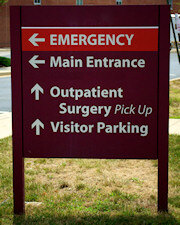Improved contact between physicians and their patients — known as "etiquette-based communications" — would improve the "inpatient experience" and could help a patient recover more quickly, a randomized trial found.

Among suggested interactions, the Johns Hopkins University study found most patients preferred physicians sitting down to talk to them eye-to-eye than looking down on them in their beds. The study, published online in the Journal of Hospital Medicine, said essential practices included doctors:
- Introducing themselves to patients;
- Explaining their role in patient care;
- Touching patients with a handshake;
- Asking open-ended questions such as "How are you feeling today?," and
- Sitting down with patients.
The study, which tracked 29 interns, called for some simple adjustments to communications to improve patients' experience of a hospital stay and to provide doctors with more information. Practicing physicians and hospitals can take some lessons from the findings to improve their patient care.
According to the study, a comforting touch can reduce anxiety and improve compliance with treatment regimens. Sixty-six percent of patients consider a physician's touch comforting, and 58 percent believe it to be healing, the study found, but it noted that interns did not touch patients in one-third of the visits, including during admitting shifts.
The message: Connect with patients, treat them as participants in the treatment and talk sincerely to them.
"Basic things make a difference in patient outcomes and they're not being done to the extent they should be," said study leader Leonard S. Feldman, M.D, an assistant professor of medicine at the Johns Hopkins University School of Medicine and one of the associate program directors of the internal medicine residency program at Johns Hopkins Hospital. "These are things that matter to patients and are relatively easy to do."
Feldman's own experience practicing etiquette-based communications shows how patients respond to this hands-on approach. He notes that when he sits down, patients often think something is really wrong. People should expect their physicians to sit down with them and introduce themselves, he says, and not be taken aback. "It's part of being a doctor," he says.
In the study, trained observers watched 732 patient visits. During these encounters, they found that the interns:
- Introduced themselves 40% of the time;
- Explained their role 37% of the time;
- Touched patients 65% of the time;
- Asked open-ended questions 75% of the time; and
- Sat down with patients 9% of the time.
The study asked interns at one site to estimate how frequently they introduced themselves and how often they sat down with patients. The interns vastly overreported how often they made these gestures. For example, they estimated that they introduced themselves and explained their role in care 80% of the time and that they sat down with patients 58% of the time — far exceeding the reality.
Worse, interns performed all five of the recommended behaviors just 4% of the time, and were only slightly more likely to introduce themselves to patients during their first encounter than a later one, researchers said.
Interns were more likely to introduce themselves during night shifts as compared to day shifts (48% versus 37%).
"Our perception of ourselves is off a lot of the time and that's why it is so important to have data," said Lauren Block, M.D., M.P.H., a former general internal medicine fellow at Johns Hopkins, who co-authored the report. She added: "It's no wonder patients don't feel connected to what we are telling them, because many times we are not doing as much as we could to make that connection."
Follow-up care is also a problem because of the lack of good doctor-patient communication, the study said.
Other research has shown that only 10 percent of patients can name a doctor who cared for them in the hospital.
The study recommended a few simple changes to personalize care:
- Provide chairs;
- Put photos of the care team in patient rooms; and
- Add lessons on etiquette-based communication to the curriculum for interns.
The hands-on etiquette communications should begin at a hospital's front door, the report said.
"As hospital admissions are a time of vulnerability for patients, physicians can take a basic etiquette-based communications approach to comfort patients and help them feel more secure," the report stated.



